Choosing the Best H55/H57 Motherboard, Part 2
by Rajinder Gill on February 22, 2010 2:00 AM EST- Posted in
- Motherboards
Gigabyte H55M-USB3
As the name suggests, Gigabyte's H55M-USB3 model brings USB 3.0 functionality to the masses at an attractive price of $110.
| Gigabyte H55M-USB3 | |
| Market Segment | H55 General Use/HTPC |
| CPU Interface | LGA-1156 |
| CPU Support | LGA-1156 i3/i5/i7 Series of Processors |
| Chipset | Intel H55 Express Chipset |
| BCLK Speeds | 100-600MHz in 1MHz increments |
| DDR3 Memory Speed | 800, 1067, 1333 Frequency Ratios |
| QPI Frequency | All supported multipier ratios available |
| Core Voltage | 0.5V ~ 1.90V in 0.00625V increments |
| CPU Vdroop Compensation | AUTO, Disabled & Enabled |
| CPU Clock Multiplier | Dependant on Processor, all available multipliers supported |
| DRAM Voltage DDR3 | Auto, 1.30V ~ 2.60V in 0.02V increments (1.50V base) |
| DRAM Timing Control | tCL, tRCD, tRP, tRAS, + 10 Additional Timings |
| DRAM Command Rate | Auto, 1T, 2T & 3T |
| PCH Voltage | Auto, 0.95V ~ 1.50V in .1V ~ 0.02V increments, 1.05V Base |
| CPU VTT (Uncore) Voltage | 1.05V ~ 1.49V in 0.05V ~ 0.02V increments |
| CPU PLL Voltage | 1.6V ~ 2.54V in 0.1V ~ 0.02V increments, 1.80V Base |
| IGD VID | 0.2V~1.68V in 0.05V ~ 0.012V increments |
| Memory Slots | Four 240-pin DDR3 DIMM Slots Dual-Channel Configuration Regular Unbuffered DDR3 Memory to 16GB Total |
| Expansion Slots | 1 x PCIe 2.0 x16 Slot 1 x PCIe x16 Slot (running at x1) 2 x PCI slots |
| Onboard SATA/RAID | 5 x SATA 3.0GB/s (Support NCQ, AHCI and Hot Plug) 1 x eSATA on Rear I/O Gigabyte SATA 2 chip: 1 x IDE, 2 x SATA 3Gb/s (RAID 0, 1 and JBOD) |
| Onboard USB 2.0/3.0 | 12 USB 2.0 ports (6) I/O Panel (one SATA combo), 6 via brackets 2 x USB 3.0 Ports (NEC D720200F1) |
| Onboard LAN | 1 x Realtek 8111D Gigabit LAN (PCI-E x1) |
| Onboard Audio | Realtek ALC889 - 7.1 Channel HD Audio (Dolby Home Theatre support). |
| Other Onboard Connectors | 1 x COM, 1 x S/PDIF In, 1 x S/PDIF Out, 1 x FP Audio, 1 x FP connector, 1 x 1394, 1 x FDD |
| Power Connectors | ATX 24-pin, 8-pin EPS 12V |
| I/O Panel | 1 x PS/2 Keyboard/Mouse 1 x RJ45 6 x USB 2.0/1.1 2 x USB 3.0 Ports (NEC D720200F1) 1 x 1394 1 x eSATA (Intel PCH) 1 x Optical Toslink 1 x DVI-D 1 x HDMI 1 x VGA/D-sub 6 Audio I/O jacks |
| Fan Headers | 1 CPU + 1 Additional Header (Both 4 Pin) |
| Fan Control | Full temp/speed fan control for CPU header via OS software No independant control for system fan header (auto controlled according to system temp) |
| Package Contents | 2 x SATA cables, 3 x User Guides, 1 x Driver/software DVD, 1 x I/O Shield. |
| Board/BIOS Revisions Used | Board Rev: 1.0 BIOS Files Used: F2, F3a |
| Form Factor | uATX (9.6 in. x 9.6 in.) |
| Warranty | 3 year standard |
The H55M-USB3 offers full support for i3/i5 processors and comes laden with a full spread of ports and slots. NEC's D720200F1 supplies USB 3.0 and you get a total of seven SATA ports thanks to the addition of Gigabyte's GSATA chip. Realtek's ALC 889 chip is used for audio duty and is supplied with Dolby Home Theatre software, which now works thanks to a BIOS update from Gigabyte. Package contents are once again limited to a couple of SATA cables, I/O shield and an IDE cable—nothing new to report there.
Software
Gigabyte provides an array of software, including DES (energy saving), Easy Tune 6 (overclocking), Q-Share (network folder sharing), and Smart 6 (backups, one touch overclocking, Quickboot, Password/date storage, event logging and user access schedules). A tool called "AUTO Green" is supplied which works with a Bluetooth cell phone—enabling power saving modes to be engaged on the motherboard whenever the Bluetooth cell phone is out of receiver range (you don't get a Bluetooth dongle with the board though). Out of all of the packages on offer, the two that you're most likely to use are the Easy Tune 6 and DES Energy Saver 2. Barring AUTO Green, the rest of the bundled software tools are simplified GUI's offering functions that are native to operating systems like Windows 7 in one guise or another (backups, user account control, etc).
Easy Tune 6 is Gigabyte's spin of OS overclocking software and allows on-the-fly changes to all voltage rails and bus frequency manipulation:
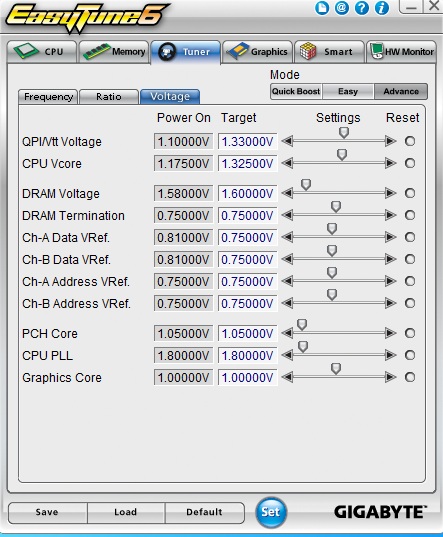
The only area of functionality that caught our attention with Easy Tuner 6 is in the department of DRAM reference voltage levels—we're not sure if all of the values are being reported correctly. The Address Vref voltages usually track changes to VDIMM and maintain a 50% ratio of the applied DIMM voltage, at least that's how they're set to default on other boards. Going by how well this board clocks memory, it's probable that the voltage levels do change behind the scenes but are just being misreported in the BIOS and EASY Tuner GUI.
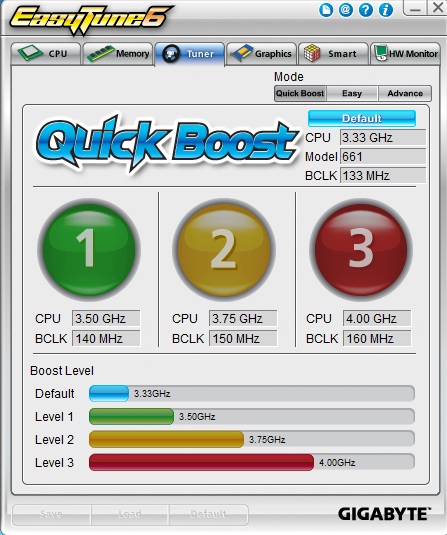
One touch overclocking profiles are available, providing a quick and easy boost up to 160BCLK. Voltage ramping is fairly moderate and the end result is a completely stable OC.
The Board
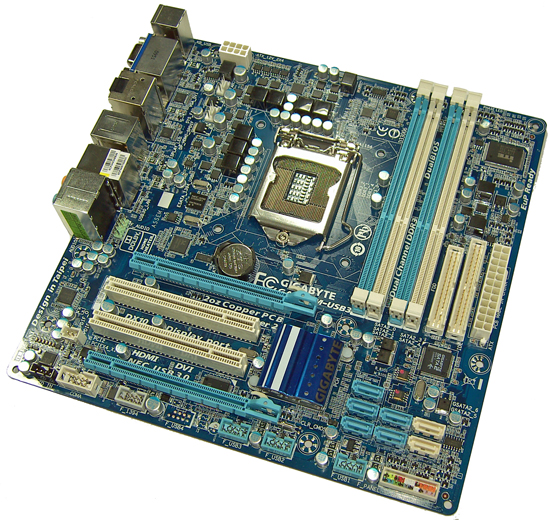
There's not much we can say to fault Gigabyte's board layout; everything is readily accessible in most situations. Although the close proximity of the DIMM slots to the primary PEG slot can make inserting memory modules a little tricky when the PEG slot is occupied with a long graphics card. We'd have liked an extra fan header as well; Gigabyte provides two on the H55M-USB3, leaving users who are overclocking with limited cooling options. By the way, despite its appearance, the lowest PCI-E slot does not run at x16 link width; it's limited to x1 by hardware—Gigabyte's inclusion of the a full length slot in this location is purely aesthetic.
The PWM area does get rather hot under heavy CPU loads, and while the FETs are within their operating limits, keeping them cool is usually not a bad idea. If you plan on pushing high memory speeds simultaneously with high CPU frequencies, active cooling of the memory will require Molex to 3-pin fan connector. Like other boards in this price range, we don't think the PWM circuits employed for CPU VCore are comfortable overclocking HT enabled Lynnfield processors much past 3.6GHz (give or take) long-term if you intend to load the CPU heavily—it's safer to run the CPU at stock in most cases.
Overclocking
The H55M-USB3 is a capable performer when it comes to memory clocking. Using the highest available QPI multiplier ratio, speeds up to 1850MHz are fully stable with our expensive Corsair Dominator GT 4GB kit:
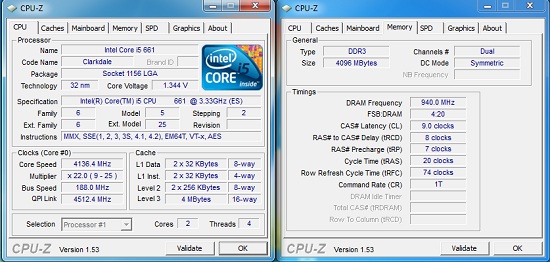
Higher memory speeds are indeed possible but need require use of a lower QPI multiplier ratio, otherwise S3 resume won't work if you leave the board in sleep state for 5~6 hours. 8GB memory overclocking is good too:
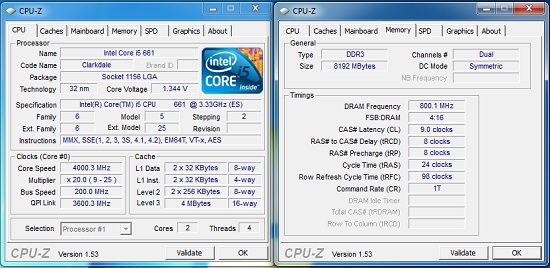
1600MHz fully stable speeds are possible with or without the IGP active, making the H55M-USB3 one of the most flexible H55/H57 boards we've reviewed to date.
BIOS
Gigabyte's BIOS is well laid out and offers plentiful options for overclockers. Fine step voltage control is available for every rail, plus you get the option to key voltages in directly without having to scroll through most of the scale. Everything else from QPI multiplier ratio control to IGP multiplier/frequency selection is also available.
BIOS flashing is made easy thanks to a built in utility called Q-Flash. Although the BIOS chips are not mounted on sockets, Gigabyte's dual BIOS allows the board to POST should one of the BIOSes become corrupt due to overclocking or a failed BIOS flash.
Over-zealous overclocking attempts can usually be recovered without having to resort to clearing the CMOS. The BIOS POST failsafe monitor is not fully automated in every regard though, there are instances where you'll have to power down the PSU and then power up again to get safe mode to engage—but it's still better than going through the rigmarole of clearing CMOS.






















56 Comments
View All Comments
7Enigma - Monday, February 22, 2010 - link
Taft,Why does the MSRP really matter? Unless you are looking to buy in bulk, I don't really see what the benefit would be. For instance the Intel 80gig SSD has been inflated for months now. It's still a great product, and I don't know why someone wouldn't buy something if the price was higher than MSRP. Many electronic products sell below MSRP, and IMO that does't make them any better or worse.
More importantly than MSRP in my opinion is shopping around to get the best price at any given point. 15-30min of googling around to various E-tailers will give you a good ballpark of the price.
Rajinder Gill - Monday, February 22, 2010 - link
Hi,Unfortunately, I haven't seen or heard of any such resource from any of the sub-vendors - I usually have to fire off emails to ask. I agree with you though, it would be nice to see the figures posted on vendor websites.
regards
Raja
willsonjone - Tuesday, March 22, 2011 - link
Samsung, a respected brand keeps introducing mobile phones that match today’s speed and technology. Samsung has gone great lengths this time as it has received impressive reviews for its new Galaxy S 4G which happens to be the first 4G Phone with 21+ Mbps speeds.Samsung Galaxy S 4G
Kid98 - Monday, February 22, 2010 - link
(ASUS is using a 188 amp capable VRM vs a guessed 110~120amp VRM on the Gigabyte H55/H57 boards, so we'd pick the ASUS boards for Lynnfield CPU overclocking)Looks like the units used to express the capabilities of the VRM's is incorrect, otherwise I am going to need a really large PSU to run them....
Kid
Swivelguy2 - Monday, February 22, 2010 - link
That's 100+ amps delivered at a Vcore of ~1 volt, not 100+ amps drawn from the 12v rail.Earballs - Monday, February 22, 2010 - link
I don't understand these Farcry 2 benchmark results.How is this score against the i5 750 being calculated? Did you test all these boards with that processor then average it? :S
If the first result is the 661@stock and the second the 661@4Ghz, why is the comparison to the i5 750 number not the same in both charts? What changed for the 750? The graphics settings appear to be the same.
Rajinder Gill - Monday, February 22, 2010 - link
The 750 was benched on the EVGA P55 FTW board. Same drives, same drivers, same GPU, same patch version of FC2. Not sure why Lynn (4core) does worse in this bench.later
Raja
Earballs - Monday, February 22, 2010 - link
Okay thanks, but that doesn't explain this:If the first result is the 661@stock and the second the 661@4Ghz, why is the comparison to the i5 750 number not the same in both charts? What changed for the 750? The graphics settings appear to be the same.
Rajinder Gill - Monday, February 22, 2010 - link
Hi,The 750 was OC'd to 4GHz in the second chart, which is why the figure is 5FPS higher than the stock number of 68fps.
I can update the graph in about a day with the 750 running in one of the H55 boards if you like - got the Intel JG on the test rig at present and it won't do 4G's with the 750 I suspect..lol
regards
Raja
Earballs - Monday, February 22, 2010 - link
Ok. It might clear things up to have the 750 labeled as OC'd in the second chart. Thanks for the replies.